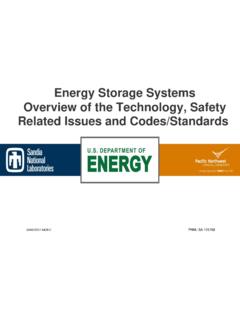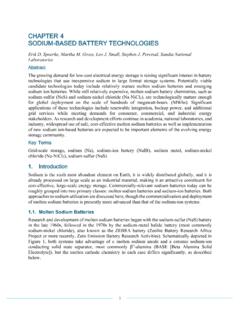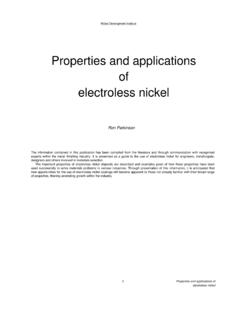Transcription of Energy Storage Systems Overview Fundamentals, …
1 PNNL-SA######/SAND########## Energy Storage Systems Overview fundamentals , Applications, Safety Issues and Codes/Standards David Conover Pacific Northwest National Laboratory Sterling, MA October 19, 2017 SAND2017-11112 PE/PNNL-SA-129843 Purpose and Expected Outcome Purpose To provide an Overview of Energy Storage (ES) technology tailored for those responsible for ensuring the safety of Energy Storage system (ESS) installations Expected Outcomes A basic understanding of Energy Storage technologies fundamentals Knowledge about the various applications for Energy Storage in the built environment APPLICATIONS Identification of safety-related issues associated with Energy Storage Systems SAFETY ISSUES Identification of the standards and codes applicable to Energy Storage Systems CODES AND STANDARDS Source - Southern California Edison Energy Storage fundamentals 3 An Overview of the different types of ESS and how they operate electro -chemical Thermal Mechanical fundamentals Energy Storage Technologies Pumped Hydro Compressed Air
2 Energy Storage (CAES) Electrical Storage (Batteries) Sodium Sulfur (NaS) Flow Batteries Lead Acid Advanced Lead Carbon Lithium Ion Flywheels Electrochemical Capacitors Energy Power long discharges (min to hr) ala a 10K short discharges (sec to min) ala a 100 m sprint BASICS 4 4 Battery Basics Batteries store Energy chemically and through electrochemical reactions produce electricity. The presence of an anode, cathode, and electrolyte provides the basis for storing Energy and satisfying Energy loads. There are a wide range of battery types, sizes, designs, operating temperatures, control mechanisms, and chemistries. Beyond storing Energy , all batteries are not created equal. Source Kamath, EPRI ES Technology Overview BASICS 5 electro -chemical ESS Types Lead-Acid (LA) Batteries two electrodes (one lead and one lead-dioxide) immersed in sulfuric acid nickel -Cadmium (Ni-Cd) Batteries two electrodes (one nickel and one cadmium) immersed in an aqueous potassium-hydroxide electrolyte Lithium-Ion (Li-ion) Batteries two electrodes (varying chemistries)
3 Na-Metal Batteries consisting of a molten sodium anode and "-Al2O3 solid electrolyte Redox Flow Batteries two electrolytes are stored in separate tanks and are pumped to a fuel cell when Energy is desired BASICS 6 Thermal and Mechanical ESS BASICS Pumped hydroelectric Storage Energy is stored in the form of a water reservoir at a higher altitude that is released through turbines to a lower reservoir and is pumped back up to the higher reservoir during periods of low Energy demand. Flywheels a spinning mass in its center that is driven by a motor. When Energy is needed, the spinning force drives a turbine, which slows the rate of rotation. The system is recharged by a motor. DOE/EPRI 2013 Electricity Storage Handbook in Collaboration with NRECA 7 SAND2015-10759 Recommended Practices for the Safe Design and Operation of Flywheels Molten salt formulations composed of mixtures of nitrates or nitrites that can store heat and then use that heat to power turbines to generate electric power.
4 Key Takeaways There are a wide range of Energy Storage technologies today and there will be more in the future. Energy , economic, and environmental issues are creating a demand for Energy Storage , and policy initiatives are accelerating that demand. Energy Storage includes batteries but also thermal and mechanical technologies. Beyond storing Energy , all batteries are not the same. The wide range of battery types, chemistries, sizes, designs, control mechanisms, operating temperatures, and potential locations suggest an almost infinite number of possibilities. Just when you think you have all the information you need there will be new Energy Storage technologies to keep you engaged. fundamentals 8 Applications of Energy Storage Systems An Overview of where and how ESS are being applied 9 APPLICATIONS SCE DESI Site Source - Southern California Edison PCS 12 kV/480 V Transformer BESS Building Switchgear Connection Point APPLICATIONS 10 SCE DESI ESS Key Components Battery system Power Conversion system (PCS) Medium Voltage Transformer Medium Voltage Switchgear and Protection Source - Southern California Edison APPLICATIONS 11 Battery system Fire Suppression system 12 kV Switchgear PCS Project Name: Auwahi Location: Maui, Hawaii Application: Wind ramp management ES Type: GSS HR (high power lithium ion) Power Rating: 11 MW Energy Capacity: MWh Battery Package: Standard containerized (9x NEC GBS grid battery system containers) Power Conversion.
5 3x inverters in outdoor-rated cabinets Balance of Plant: Chilled water unit for battery thermal management Transformers and switchgear appropriate to substation Commercial December 2012 Operation: Auwahi Wind Farm, HI APPLICATIONS 12 ESS Application Examples DOE ESS Database Xtreme Power ESS at a Castle & Cooke MW MW AC advanced lead-acid battery that doubles the output of the solar system and control the ramp rate. ZZB Energy Corporation at Hawaiian properties 60 kW zinc bromine flow battery that is part of an elevator system in an R-2 building that uses grid power and power from a 20 kW PV array. Iron Edison at Confidential 48 kW nickel iron battery powered by a pole-mounted solar array. Maxwell Technologies at Long Island RR electro -chemical capacitor to provide voltage support to assist traction power system (capture and store Energy produced by trains to help with acceleration).
6 SAFT at Scripps Ranch Community Center 30 kW lithium-ion ESS used for PV Energy Storage . Mitsubishi at Santa Clara Data Center kW electro -chemical VLRA applied as a UPS. APPLICATIONS 13 Database of Applications APPLICATIONS 14 Safety Issues Siting (location, loads, protection, egress/access, maximum quantities of chemicals, separation, etc.). New versus existing Systems and new versus existing building/facility applications. Stationary, mobile, and portable Systems vary in application and use. Ventilation, thermal management, exhausts (when necessary, flow rates, how controlled, etc.). Interconnection with other Systems ( Energy sources, communications, controls, etc.). Fire protection (detection, suppression, containment, smoke removal, etc.). Containment of fluids (from the ESS and from incident response).
7 Signage, markings, and security. Identification of the applicable authorities having jurisdiction (utility, federal, state or local government, etc.). 15 SAFETY ISSUES Safety Takeaways Energy Storage technologies may or may not be similar to other technologies; the system and its component parts must be validated as being safe. The safety of an Energy Storage technology is also affected by the location in which it is installed and manner in which that installation is implemented. While there are a set number of safety issues, the manner in which they are addressed to ensure safety is significant due to the number of variables associated with the technologies and their relationship with the built environment. Safety does not stop when a new system is commissioned, and the safety issues remain relevant through operation, repair, or renewal of the system , any needed recommissioning, and finally through decommissioning.
8 SAFETY ISSUES 16 Model Codes and Standards Model codes and standards in the aggregate address the design, construction, commissioning, rehabilitation, operation, maintenance, repair, and demolition of components of the built environment, such as buildings, facilities, products, Systems , and equipment therein. Standards each have a very specific scope and where needed will reference other standards. Model codes reference standards. Regulations, rules, laws, specifications, tariffs, contracts, and other means are the vehicles by which those model codes and standards are adopted. When adopted, the model codes and standards must be satisfied subject to any penalties associated with noncompliance. 17 CODES AND STANDARDS Model Codes and Standards CODES AND STANDARDS CS for ESS Components CS for ESS Installation Overarching CS CS for Complete ESS 18 Address the installation of the ESS in relation to other Systems and the built environment Cover the built environment at large and that includes the ESS The entire ESS in the aggregate Components associated with or part of the ESS Model Codes and Standards NFPA 1-15 Fire Code 70-17 National Electric Code 5000-15 Building Code ICC 2015 International Fire Code 2015 International Residential Code 2015 International Mechanical Code 2015 International Building Code IEEE C2-17 National Electrical Safety Code CODES AND STANDARDS 19 Overarching CS Model Codes and Standards NFPA 855-X Standard for the Installation of Stationary
9 Energy Storage Systems NECA 416-17 Recommended Practice for Installing Stored Energy Systems IEEE 1653-2012 Guide for Ventilation and Thermal Management of Batteries for Stationary Applications P1578 Recommended Practice for Stationary Battery Electrolyte Spill Containment CODES AND STANDARDS 20 CS for ESS Installation Model Codes and Standards ASME TES-1 Safety Standard for Thermal Energy Storage Systems NFPA 791-14 Recommended Practice and Procedures for Unlabeled Electrical Equipment UL 9540 Safety of ES Systems and Equipment CODES AND STANDARDS 21 CS for Complete ESS Model Codes and Standards UL 810A Electrochemical Capacitors 1642 Standard for Lithium Batteries 1741 Inverters, Converters, Controllers and Interconnection system Equipment for Use with Distributed Energy Resources 1973 Batteries for Use in LER and Stationary Applications 1974 Evaluation of Batteries for Repurposing CSA CSA No.
10 Power Conversion Equipment IEEE Guide for the Characterization and Evaluation of Lithium-Based Batteries in Stationary Applications IEEE Guide for the Characterization and Evaluation of Sodium-Beta Batteries in Stationary Applications CODES AND STANDARDS 22 CS for ESS Components Model Codes and Standards Ongoing information about model codes and standards is provided Regular webinars involving the relevant standards development organizations A monthly codes and standards report CODES AND STANDARDS 23 Key Takeaways Development and maintenance of model codes and standards is an ongoing process open to all interested parties and is facilitated by a number of standards development organizations. Advancements in Energy Storage technology and lessons learned from existing system installations will necessitate continual updating and enhancement of codes and standards.







